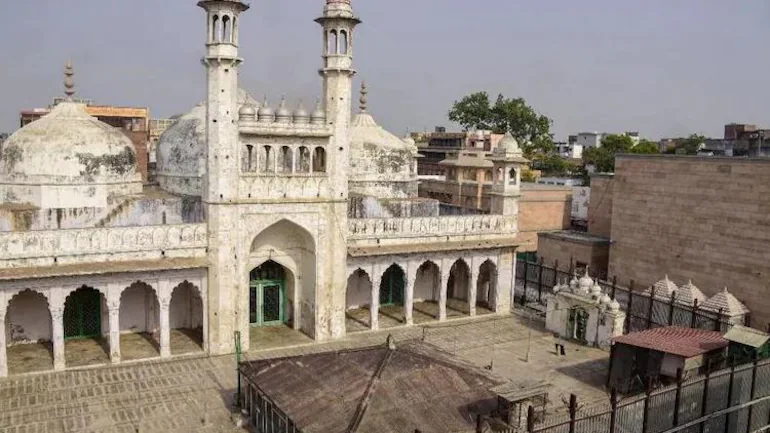A new issue with roots laid centuries back has gripped the nation in a new debate. The issue is a tussle between two countries. Here one claims that a mosque in Varanasi has always been a mosque while the other claims it was a temple that was destroyed and then the mosque was built at the place.
The case is about the Gyanvapi mosque where now the security in Varanasi particularly near the mosque has been increased while the Supreme Court holds hearings to decide on a case stemming from a petition filed in 1991.
Earlier the local court making the hearings on the case asked for detailed videography of the place to investigate the claims made by both sides. As per sources, some people alleged that a ‘shivling’ was found during the process and the court asked to seal the place. Following this decision, a petition was made to the top court that is holding hearings on the matter.
The case began when five Hindu women filed a case in Varanasi court. They asked for permission and access to offer daily prayers at the Hindu site Maa Shringar Gauri located outside the western wall of the Gyanvapi mosque.
The historical claims made in the case until now
The Gyanvapi mosque is situated near the renowned Kashi Vishwanath temple in Uttar Pradesh’s Varanasi. Some people believe that before reconstructions in the past, the temple had an extended presence, up to the place where Gyanvapi mosque is situated now.

At the same time, some historians allege that it was the Mughal ruler Aurangzeb who is said to have destroyed that temple along with many temples in the 17th century by constructing the Gyanvapi mosque in his reign. Some historians approve of the claim, while others say that there was no temple there, and it has been a mosque since the 17th century adjacent to the temple.
The petitioners have claimed that the Kashi Vishwanath temple was built by Maharaja Vikramaditya more than 2,000 years ago. So, the mosque was built by Mughal emperor Aurangzeb in 1664 after he ordered the demolition of the temple.
Further, they claim that the mosque was built on a specific portion of the land using the ruins of an old temple. For this reason, they claim that the remains of the old temple will still be along with the mosque.
The legal battle begins
The matter of the Gyanvapi Mosque-Kashi Vishwanath temple was taken to court in 1991. A petition was filed to get the mosque removed from that particular place. Also, it demanded the transfer of the land to the Hindu community.
Interestingly, the Gyanvapi mosque was a part of the three religious places the Vishwa Hindu Parishad (VHP) wanted to “liberate”. They wanted to liberate the places during the Ram Janmabhoomi movement. Apart from it, the other two places were the Ayodhya’s Babri Masjid and the Shahi Idgah in Mathura.

In 1998, the managing committee of the mosque filed a case under the provision of the Places of Worship (Special Provisions) Act, 1991. But, the court dismissed the application and the committee went to the High Court.
The committee claims the temple and mosque have been existing together and both the communities offer prayer without any interference. However, the proceedings in the case resumed in 2019 after 20 years.
The Places of Worship act 1991
During the Ram Mandir Movement in Ayodhya, the then P.V. Narasimha Rao led government enacted the new Place of worship Act of 1991. It was said to be made for maintaining communal harmony. As per the Act, the religious character of places of worship shall be maintained as they existed on August 15, 1947. But, the Ayodhya dispute was kept out of the case because it was already under legal trial.

The main purpose of the Act was to prevent any new claims by any group over the past status of a place of worship. Also, it was made to prevent any claiming back of the structure or land on which a place of worship stands.
The much-debated section 4 of the Act makes it clear that all the remaining cases of places of worship in the legal court will be ended. At the same time, no more hearings or further progress will be made or filed.
Some places were exempted under section 4 of the Act, like ancient or historical monuments, archaeological sites and other remains. Those places are covered by Ancient Monuments and Archaeological Sites and Remain Act, 1958. Also, it did not apply to any settled case before the law was implemented.
The case re-emerged
In December 2019, the decision of the much controversial Ram Janmabhoomi-Babri Masjid dispute was delivered. The then CJI-led constitutional bench allotted the disputed land to the Ram Janmabhoomi trust for the construction of a temple.
After the decision, one of the counsels of the case filed a plea for seeking a survey of the Gyanvapi Mosque complex by the Archeological Survey of India (ASI). This year, a group of 5 women linked with the Vishwa Vedic Sanatan Sangh filed a petition in April. They have filed the petition seeking daily access to Maa Shringar Gauri sthal (holy site) in the Gyanvapi mosque-Kashi Vishwanath complex.

They presented the images of the goddess Shringar Gauri who is present at the back of the western wall of the Gyanvapi Masjid. Consequently, the Civil judge appointed an advocate commissioner to survey the site and look for the presence of the claims, but it was interrupted by the mosque management. But, the court ordered the continuation of the process and appointed two additional advocate commissioners. Also, the Uttar Pradesh Chief Secretary and the Director-General of Police were asked to supervise the process.
As of now,
The videography of the case has been done, and both sides have different calms. The matter is in the Supreme Court. The top court is conducting the proceedings in the case and will make a decision on the matter. Whatever the decision is, the case is sure to have wide and long-lasting impacts.
Also Checkout: Famous ex-cricketer/politician facing jail time for a three-decade-old case
















